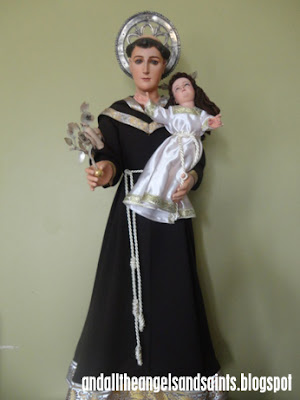STA. MARIA MAGDALENA (St. Mary Magdalene) is one of the principal figures of Holy Week processions in the Philippines, and an image of her is almost mandatory in Lenten rites. That's because she was present at the two most significant events in Christ's life--his Crucifixion and Resurrection.
Beside these, Magdalene's presence was noted many times during Christ's ministry and was well-known to His apostles, which spoke well of her courage and support.
Her name--Magdalene--was derived from her town of residence called Magdala, in northern Galilee, and her culture and manners were those of a Gentile. She had an early reputation as a sinner and has been called a harlot and adulteress.
After meeting Jesus, she felt deep remorse for her life of decadence. At the home of Simon where Jesus was invited to sup, Mary came to weep at his feet, which she wiped with rich unguents using her long, luxuriant hair.
Addressing the people who were shocked at the sight of a sinner touching Him, Jesus said: "Many sins are forgiven her, because she has loved very much." To Mary, He said: "Your faith has made you safe; go in peace."
Thus, Mary became a follower of Jesus from that moment on, never leaving him during His Passion. She was at the foot of the cross when Jesus expired, and was there that fateful Easter Sunday morning when she discovered His missing body which she had prepared to anoint with spices. The weeping Mary was called by name by a man, whom she instantly recognized as the Risen Jesus.
In Christian art, where she was the most commonly depicted female figure after the Virgin Mary, she shown wearing lavish fashions. In the Philippines, the liturgical colors assigned to her are pink and yellow.
Her hair is long and unbound, either blonde or reddish-blonde. She is shown holding a vial of perfume and a handkerchief, which she used to wipe the feet of Jesus. One hand holds her long, unveiled tresses.
Other representations include her being a desert hermit, shown naked, holding a skull and covered only with her long hair--which could have been confused in the West with the 4th century hermit, St. Mary of Egypt.
There are also depictions of Mary Magdalene kneeling at the foot of the Cross, sometimes clutching the Cross itself. When shown standing, she is placed at the left and behind Mary and John, in a gesture of grief.
Until recently, the Roman Catholic Church identified Sta. Maria Magdalena as Sta. Maria Betania (sister of San Lazaro and Sta. Marta) , a notion abandoned in the early 1990s. St. Mary Magdalene is the patroness of penitents and perfumers. She is the titular patron of the revolutionary town of Kawit, Cavite where she is endearingly called "Santa Nena". Her Feast Day is July 22.
CREDITS: All photographs taken by Dr. Raymund Feliciano.





















































